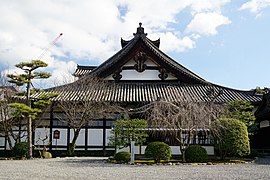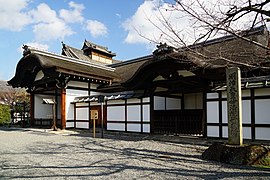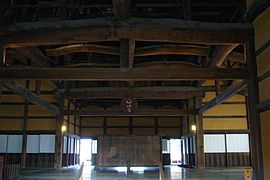Myōhō-in
The Myōhō-in ( Japanese 妙 法院 ) is a temple of the Tendai direction of Buddhism. It is located in the Higashiyama district on the eastern edge of the city of Kyoto .
history
According to his own tradition, the monk Saicho is said to have founded the temple. It is more likely that the monk Shōun ( 昌 雲 ) created it on behalf of the emperor Go-Shirakawa . At the beginning of the Kamakura period , the temple was relocated to the Ayanokōji ( 綾 小路 ) hillside path near the Kennin-ji and was accordingly called Ayanokōji-Klause. The temple was later moved back. Throughout history, the abbots have often come from the imperial family. And since they also belonged to the superiors of the Tendai sect, the importance of the temple also grew. In the Middle Ages, however, the temple was besieged by the sword nobility. In 1340, Sasaki Dōyo ( 佐 々 木 道 誉 ; † 1373) attacked him, and the temple burned down completely.
The temple recovered afterwards, but was devastated again in the Ōnin war . When Toyotomi Hideyoshi had the hall for the great Buddha of Hōjō-ji built, he also had the main hall built for this temple. In the Edo period, the income of the Myōshin-ji was a sizable 1,600 koku . He also administered the Shinhiyoshi Shrine ( 新 日 吉 神社 ), the Sanjūsangen-dō and the Hōkō-ji.
During the Temmei Great Fire ( 天明 の 大火 ) in 1788, Emperor Kōkaku sought protection here. And in 1862, towards the end of the Tokugawa period , seven court nobles set out from here to overthrow the shogunate. After the Meiji Restoration and the associated suppression of Buddhism, the area of the temple was reduced to 1/20.
For a long time it was disputed when Hideyoshi supported the temple. A recently found document proves that the building was already in the Bunroku period (1592–1595). Some time ago the northern garden area from the Heian period , das ( 積 翠園 , Shakusui-en ), was sold to the Japanese monopoly administration ( 専 売 公社 , Sembai kōsha ).
The attachment
The temple is located on the Higashi-Ōji and is surrounded by a stone wall and a rampart ( 築 地 堀 , Zuijibei ). You enter the temple through a simple gate, next to it there is also a gate in the elaborate Karamon style. The historically most important building of the temple is the refectory. It comes from the Momoyama period and is registered as a national treasure (hereinafter marked with ⦿). It is as important as that of Zuigan-ji on the Miyajima and has a high roof structure with a cleverly designed smoke outlet. The entrance and the large reception room ( 大 書院 , Daishoin) are registered as important cultural assets ( hereinafter marked with ◎). You have been moved here from a residence of Emperor Go-Mizunoo . The wall paintings in the reception room are all by painters from the Kanō School .
In the small reception room ( 白 書院 , Shiroshoin ), the black horses, painted by Kanō Sanraku (1559–1635), stand out. There are also landscape paintings by Goshun and a painting by the monk Gessen ( 月僊 ; 1741–1809) depicting a group of hermits. In the "Dragon Flower Storage" ( 龍華 蔵 , Ryūgezō ) called treasure house are objects that once belonged to Hideyoshi. The letter from the Portuguese Vice Regent of India ( ポ ル ト ガ ル 国 印度 福王 信 書 , Porutogaru-koku Indo fukuō shinsho ; ⦿) was sent to Hideyoshi in 1588 by Don Duarte. Scrolls and handicraft objects (some ◎) can also be seen.
photos
Remarks
- ↑ The attack by the seven court nobles failed. But they were able to flee to western Japan and find shelter with the Chōschū clan. The incident went down in history as the "Case of the Seven Court Nobles " ( 七 卿 落 ち , Nanakyō-ochi).
literature
- Yamamoto, Jirō: Myoho-in . In: Kyoto-fu no rekishi sampo (jo). Yamakawa Shuppan, 1999. ISBN 978-4-634-29260-4 . P. 167.
Web links
Coordinates: 34 ° 59 ′ 25.3 " N , 135 ° 46 ′ 31.4" E





